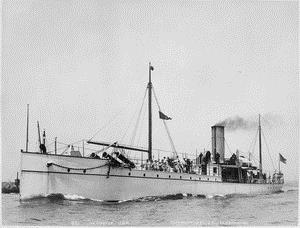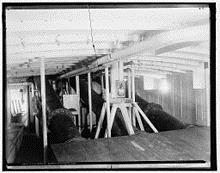The following is part of Dead Ends Week at CIMSEC, where we pick apart past experiments and initiatives in the hopes of learning something from those that just didn’t quite pan out. See the rest of the posts here.
These days, the Spanish-American War is mostly remembered for Roosevelt’s Rough Riders, “Remember the Maine!” and America’s emergence upon the world stage. Within the maritime domain, we also remember it as a showcase for the United States’ new steel navy and the technical innovations which laid the groundwork for the Great White Fleet and beyond. All the basics were there – steam power, electricity, large-caliber guns, and armor plating.
But they also had some things that didn’t quite make it.
Among them was the USS Vesuvius. Vesuvius was commissioned in 1890 as a unique animal in the navies of the world – a dynamite gun cruiser. The 900-ton ship’s main battery was composed of three guns that fired dynamite-filled rounds using compressed air. The rationale for the pneumatic system was a reduced chance of prematurely detonating the ordnance from the shock of firing. Depending on the weight of ordnance launched, Vesuvius’s range was anywhere from 2000 to 4000 yards. A major drawback was that the guns were fixed, so aiming required maneuvering the entire ship.
Dynamite gun muzzles aboard Vesuvius
Despite the weapons’ short range and difficulty with targeting, Vesuvius still saw remarkable success during the war in Cuba. Although primarily used as a dispatch vessel, owing to her small size and high speed (21 knots!), Vesuvius still participated in eight shore bombardments of Santiago. It would quietly sneak near shore under cover of darkness and, with no more noise than a sound “like a cough,” would launch several dynamite rounds into the city. Because of the silence of the guns, there was no warning before the explosions came. It is doubtful the bombardments had much practical effect on Spain’s technical ability to fight, but it had a devastating psychological effect on Spanish troops in the city –troops who went on to lose the war at the Battle of Santiago.
The dynamite gun didn’t last past the war in the U.S. Navy, though. USS Vesuvius was removed from service in September 1898 and repurposed as a torpedo-testing vessel. Torpedo tubes replaced the pneumatic tubes, and the ship enjoyed a happy life plying the waters off of Newport, Rhode Island, into the 1920s.
The three dynamite guns below deck on Vesuvius
And with that, the dynamite gun’s brief chapter in naval history was closed. But, whether intentional or not, it still managed to demonstrate two principles that would only grow in importance as time passed.
At a technical level, the same basic pneumatic technology that launched rounds packed with dynamite is also what launches torpedoes today, from both surface ships and submarines – just one of a myriad of systems to which compressed air is critical.
Vesuvius underway in 1891
At a strategic level, the dynamite gun’s employment in the Spanish-American War anticipated, at a very small scale, the use of terror weapons such as the Paris Gun, area bombing, V-1 and V-2 in later decades. Vesuvius clearly had no ability to hit a specific target, but its ability to impact a general area was unrivaled due to its “stealth” qualities. Whether any Spanish troops were actually killed by Vesuvius is tough to say – but without a doubt, the city of Santiago feared the night.
Matt McLaughlin is a Navy Reserve lieutenant who has fired air guns before, but none quite this big. His opinions do not represent the Department of the Navy, Department of Defense or his employer.




